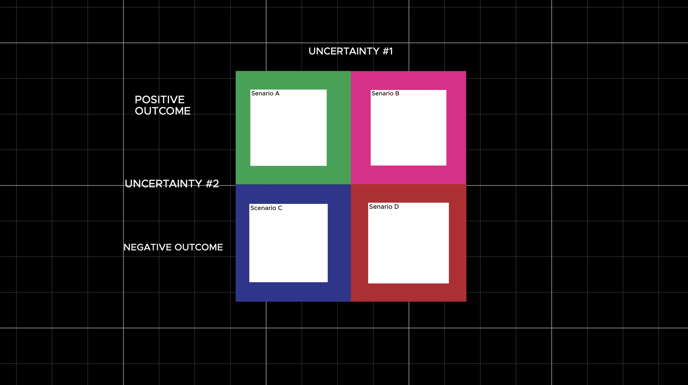Learn how to use ThinkHub for scenario planning with a template featuring four quadrants for different scenarios. Visualize uncertainties, positive and negative outcomes, and develop strategies for each scenario.
Scenario planning is a strategic technique that involves creating multiple hypothetical scenarios to anticipate and prepare for future uncertainties. ThinkHub, a versatile collaboration tool, can be a valuable asset in the scenario planning process, helping you and your team visualize, analyze, and strategize for different possible futures.

Step 1: Download the ThinkHub Template
Step 2: Define the Scope and Objectives
Begin by defining the scope of your scenario planning exercise. What are the key uncertainties or factors that could impact your organization's future? What are the objectives you hope to achieve through scenario planning? ThinkHub's digital canvas provides a flexible space to brainstorm and outline these key elements.
Step 3: Identify Key Drivers and Uncertainties
Identify the key drivers and uncertainties that will shape your scenarios. These could include economic trends, technological advancements, regulatory changes, or shifts in consumer behavior. ThinkHub's digital whiteboard and note-taking features can help you capture and organize these factors visually.
Step 3: Develop Scenario Narratives
Use ThinkHub's template for scenario planning, which features four quadrants: Scenario A, Scenario B, Scenario C, and Scenario D. You are welcome to customize this template to include more scenarios.
In each quadrant, identify two uncertainties and their potential positive outcomes at the top, and negative outcomes at the bottom. Develop narrative descriptions for each scenario, detailing the sequence of events, the implications for your organization, and the decisions that may need to be made in each scenario.
Step 4: Analyze Impacts and Strategies
Analyze the potential impacts of each scenario on your organization's goals, operations, and stakeholders. Use ThinkHub to map out these impacts visually and brainstorm strategies to mitigate risks and capitalize on opportunities in each scenario.
Step 5: Monitor and Review
As new information becomes available or circumstances change, continue to monitor and review your scenarios. You will want to update and revise your scenarios based on new insights or developments.
Scenario planning is a valuable tool for anticipating and preparing for future uncertainties, and ThinkHub can enhance this process by providing a collaborative and visual platform for brainstorming, analyzing, and strategizing for different possible futures. By leveraging ThinkHub for scenario planning, you can enhance your organization's resilience and agility in the face of uncertainty.
